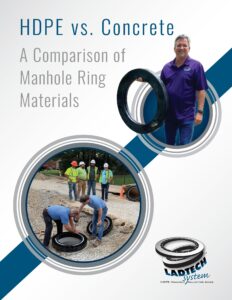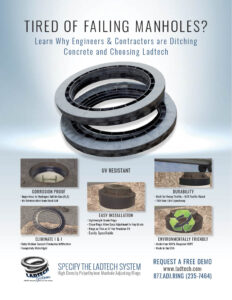HDPE vs. Concrete: A Comparison of Manhole Ring Materials

Across North America, municipalities have a decision to make regarding the manhole rings used in their infrastructure. The choice is between traditional concrete rings and the more recently developed high density polyethylene (HDPE) rings. The rings must resist inflow & infiltration (I&I), which can occur as the result of corrosion caused by hydrogen sulfide gas (H2S) or deterioration caused by heavy traffic vibration and freeze/thaw cycles. Municipal decision-makers are tasked with specifying a system that offers performance and durability while remaining mindful of their budget.
Concrete has been the conventional choice because it’s been around the longest and is familiar to engineers and contractors. Yet, HDPE has emerged in the last 30 years as a reliable alternative. This white paper provides a comparison of concrete manhole rings and HDPE manhole rings.
Featuring comments from city engineers and contractors, readers will gain insight into the issues faced by municipalities today and the factors that are considered when making decisions that impact key components of infrastructure.
Ringing Out the Old – HDPE Manhole Rings Look to Collar New Roads
From Alaska to the Bahamas, Minnesota to Texas, municipalities are taking a deeper look at the durability and life-cycle costs associated with manhole collars. Too often these systems for topping off, reinforcing and adjusting road elevations are a secondary line item in a larger storm sewer installation project, lumped into the overall task of final adjustments.
Conventional practice is to use concrete or brick and mortar to form a collar—which is often the first component to deterioration from the constant pounding and vibration of vehicles and/or weather, especially freeze/thaw conditions. Led by some proactive agencies in Minnesota, public works engineers around the country are rethinking concrete collars. They are switching to fully recycled high-density polyethylene (HDPE) manhole adjusting rings that are more economical, lighter and durable.
Inside the Ring
First manufactured in the 1990s, HDPE manhole adjusting rings are made from 100% recycled plastic or high-density polyethylene (as defined by ASTM Standard D4976). The rings are designed to meet ASTM and AASHTO HS-25 specifications. The HDPE manhole adjusting ring was tested by American Engineering Testing, a third-party laboratory. The rings were loaded to 80,000 lbs. and remained in serviceable condition. In fact, failure of the concrete catch basin and the manhole cover frame assembly halted further testing. Water penetration tests under ambient laboratory conditions were also conducted and showed no significant leakage.
Comparing the load/deflection performance of the ring stack exposed to asphaltic concrete with a similar unexposed ring stack, the deflection of the exposed ring stack was less than the unexposed stack (0.173 in. vs. 0.226 in.). In addition, HDPE materials will not corrode or deteriorate when exposed to the harsh hydrogen-sulfide environment found in most sewer systems.
Stacked Up
The HDPE collars were first installed on sanitary man- holes in 1996 in Apple Valley, a community outside Minneapolis-St. Paul, Minn. Jim Fruechtl, former city engineering construction coordinator with Apple Valley Public Works Dept., recalls, “We had such a problem with manhole collars in our harsh conditions that we decided to give HDPE rings a try to see if laboratory testing translated to real-life conditions.”
The engineering department regularly checked the col- lars over the following winter and next few years. “There was no deterioration, cracking or breaking,” Fruechtl confirms.
He performed his own test, setting a steel plate on one of the HDPE rings and driving a loaded cement truck over it. He explains, “I wanted to see if I could crush it—but it passed with flying colors.” By 1998, Apple Valley specified HDPE collars exclusively. Fruechtl notes, “Initially contractors resisted because it was something new. But they learned to like them mostly because installation is much faster and safer.”
On average, it takes 1–2 hours to install a concrete manhole cover, and then the crew has to return later in the day to backfill to match grade. With the HDPE, installation is 20–30 minutes, and crews can immediately begin back- filling and tamping. The system is ready for asphalt overlay within 10.5 hours. Crews like working with the lightweight (6-lb) HDPE rings that don’t crack or break, and there’s no leftover material.
National Attention
To-date, the HDPE rings are now sole-sourced in more than 70 Minnesota cities as well as many cities in states that face freeze/thaw conditions and those with challenging soil conditions. In McAllen, Texas, HDPE rings are helping increase longevity of manhole covers in the region’s highly acidic soils since HDPE is highly resistant to stress cracking from exposure to chemicals and gases.
Just recently, the Washington Suburban Sanitary Com- mission (WSSC), among the largest water and wastewater utilities in the nation, approved HDPE collars for use by the maintenance division. In total, more than 4 million HDPE rings are in service nationwide with no signs of breakage or degradation.
Fruechtl confirms, “We installed HDPE rings 20 years ago, and they look exactly the same today. These installs have eliminated inflow and virtually eliminated reconstruct.”
Rethinking Manhole Solutions
What if a city engineer had the power to reduce manhole and catch basin ring costs by 50%, while dramatically reducing installation time and effort? Bryan Houle, president of contracting firm C.W. Houle in Shoreview, Minn., says he has the experience to know that’s an option. “They just need to specify HDPE rings in the construction documents,” he says.
Houle’s crews have installed HDPE rings in more than 1,000 manholes, which gives him the breadth of experience to back up such claims. While LadTech has been producing lightweight manhole products for more than 20 years, many of its innovations have quietly impacted the processes and products that bring efficiency and longevity to the industry. “It takes time to change hearts and minds, even when the facts bear out the value,” says LadTech CEO Dwight Wiedrich.
“Since the HDPE rings do not deteriorate like concrete, they are specified more frequently, leading to the placement of hundreds of rings in manholes throughout Canada.”
—Dwight Wiedrich, CEO, LadTech
For example, Wiedrich says that one sewer system client in Windsor, Ontario, explained that his team could install the HDPE rings much more quickly than typical concrete rings since they are lighter and don’t rely on mortar and shims. “Windsor has to deal with significant truck traffic and with the freeze and thaw cycles in that geography so traditional concrete rings were having to be replaced frequently,” Wiedrich says. “Since the HDPE rings do not deteriorate like concrete, they are specified more frequently, leading to the placement of hundreds of rings in manholes throughout Canada.”
Houle backs that perception. “During cold weather especially, you don’t have to wait for the concrete to set up,” he says, “leading to quicker completion and far less time and labor.” In California, a municipality found HDPE rings to be the right solution to some of its challenges as well. “A supervisor at a sewer utility told me that our rings are easier to work with versus the standard concrete rings, and repair crews have told him how easy the various sizes are to use,” Wiedrich says.
Extension Ring Adapts to Changing Surface Issues
Extension rings are another product that bring added value to the HDPE rings. A molded plastic extension ring can be used to increase the height of manholes or catch basins when surfacing or resurfacing a roadway. Development of this concept resulted in a patent for Wiedrich.
“Contractors and department of transportation engineers had complained to me that they often needed a fraction of an inch more to match a finished grade,” he says. “In response, we created spacer rings to use on top of adjustable rings that raise the chimney heights in quarter-inch increments to match the finished grade.”
The system also provides a wedge to adjust the angle of the catch basin support frame or the manhole cover support frame. The extension includes a pocket for reducing the total surface area of the molded plastic member and provides a shoulder that interlocks with either the manhole cone, the catch basin cone or other stackable molded plastic members. The extension also contains a planer support surface, which provides rigidity as well as a surface where caulking can be applied to create a watertight seal.
Engineering Community Embraces Ingenuity of HDPE Manhole Solutions
Every facet of the construction industry is driven in one way or another by the bottom line. Similarly, local governments responsible for maintaining and improving infra- structure must be mindful of their budgets, especially since municipalities are challenged with limited funding. Today’s civil engineers play a huge role in helping city managers balance construction priorities with fiscal responsibility. One strategy is to recommend out-of-the-box solutions to either cut upfront construction costs or preserve infrastructure for longer periods. But what if you could achieve both?
You can when you utilize high-density polyethylene (HDPE) manhole rings, which feature a mortarless, water- tight assembly with a precision fit suitable for a wide range of slopes and sizes. Engineered and designed to replace all existing concrete, brick and rubber ring products, an HDPE system is capable of reducing manhole and catch-basin ring costs by 50%. In addition to being more economical, this solution is easier to use, functions better, requires less maintenance and is made from recycled waste material.
HDPE rings are designed to meet ASTM and AASHTO HS-25 specifications and other standards. Furthermore, they have undergone rigorous testing by American Engineering Testing, a third-party laboratory, and proven capable of lasting 80-100 years. This durable, corrosion-resistant product is competitively priced and offers considerable life-cycle savings in comparison to concrete systems, which typically last five to 25 years. These and other data-driven advantages are reassuring to specifying engineers seeking products with reliable, verified performance results.
Since the 1990s, HDPE rings have been installed in millions of manhole chimney sections across the United States, Canada and the Bahamas. Many city engineers have tested these products on their own terms – and have been surprised and encouraged by the results. For example, Jim Fruechtl, former city engineering construction coordinator with the Public Works Dept. in Apple Valley, Minn., decided to give HDPE rings a try to see if laboratory testing translated to real-life conditions. His team monitored the product’s performance over the course of several years and found that it easily withstood the constant pounding and vibration of vehicles and also weather, including harsh freeze/thaw conditions. “There was no deterioration, cracking or breaking,” Fruechtl confirms. By 1998, Apple Valley specified HDPE collars exclusively. Fruechtl notes, “We installed HDPE rings more than 20 years ago, and they look exactly the same today. These installs have eliminated inflow and virtually eliminated reconstruct.”
Hundreds of other municipalities have implemented the HDPE System, some following Apple Valley’s example in only specifying those products for manhole construction. In total, more than 4 million HDPE rings are in service nationwide with no signs of breakage or degradation. This trend serves to show that when industry professionals and municipalities break convention to embrace an innovative, proven technology, others are sure to follow suit.
Now more than ever, creative solutions such as this are needed to improve city infrastructure and free up resources for other priorities. Ladtech CEO Dwight Wiedrich states, “HDPE rings are approved in every state, including Alaska and Hawaii. In Minnesota alone, they make up about 80 per- cent of rings used in the state. The buy-in comes from establishing trust and rapport with local general contractors and infrastructure planning representatives. The true success, however, comes from sharing the value of the products with engineering professionals. Their stewardship of communities is focused on ingenuity – and HDPE meets that criteria.”


